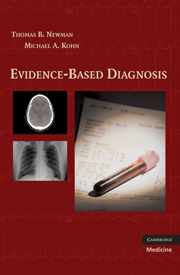Book contents
- Frontmatter
- Contents
- Preface
- Acknowledgments & Dedication
- Abbreviations/Acronyms
- 1 Introduction: understanding diagnosis and diagnostic testing
- 2 Reliability and measurement error
- 3 Dichotomous tests
- 4 Multilevel and continuous tests
- 5 Critical appraisal of studies of diagnostic tests
- 6 Screening tests
- 7 Prognostic tests and studies
- 8 Multiple tests and multivariable decision rules
- 9 Quantifying treatment effects using randomized trials
- 10 Alternatives to randomized trials for estimating treatment effects
- 11 Understanding P-values and confidence intervals
- 12 Challenges for evidence-based diagnosis
- Answers to problems
- Index
- References
8 - Multiple tests and multivariable decision rules
Published online by Cambridge University Press: 04 August 2010
- Frontmatter
- Contents
- Preface
- Acknowledgments & Dedication
- Abbreviations/Acronyms
- 1 Introduction: understanding diagnosis and diagnostic testing
- 2 Reliability and measurement error
- 3 Dichotomous tests
- 4 Multilevel and continuous tests
- 5 Critical appraisal of studies of diagnostic tests
- 6 Screening tests
- 7 Prognostic tests and studies
- 8 Multiple tests and multivariable decision rules
- 9 Quantifying treatment effects using randomized trials
- 10 Alternatives to randomized trials for estimating treatment effects
- 11 Understanding P-values and confidence intervals
- 12 Challenges for evidence-based diagnosis
- Answers to problems
- Index
- References
Summary
Introduction
In Chapter 3, when we introduced dichotomous tests, the LR of a positive result [LR(+)], and the LR of a negative result [LR(−)], we also made a point of distinguishing between prevalence and prior probability. Recall that prior probability is the more general term. The prior probability is equal to the prevalence of the disease in the population only when we do not know anything else about the patient. This is often the case for screening tests applied to large populations without obtaining information on individuals that allows differentiation between them. Although we tend to focus on laboratory or imaging tests, any new information about the patient can be used to update the prior probability of disease from what is known about the prevalence of disease in the population. As soon as we obtain individual-level information by taking a history and doing a physical examination, we develop a different estimate for the prior probability than the prevalence of the disease.
In this chapter, we discuss combining multiple types of information – elements of history, findings on physical examination, laboratory results, or radiographic images. We cover (at least theoretically) how we might get from prevalence to prior probability based on the history and physical examination, and then to posterior probability based on additional information from diagnostic tests. We begin by reviewing the concept of test independence, and then we discuss how to deal with departures from independence, which are probably the rule rather than the exception.
- Type
- Chapter
- Information
- Evidence-Based Diagnosis , pp. 156 - 185Publisher: Cambridge University PressPrint publication year: 2009



